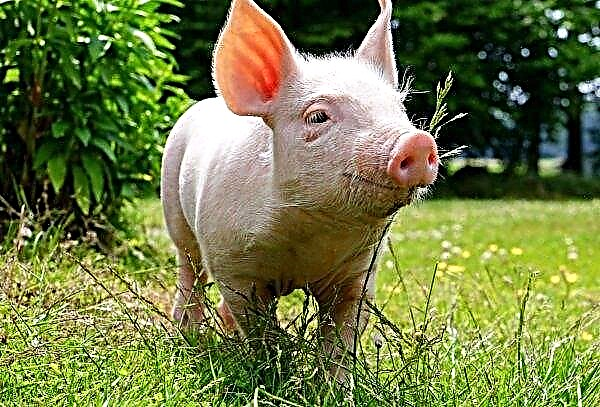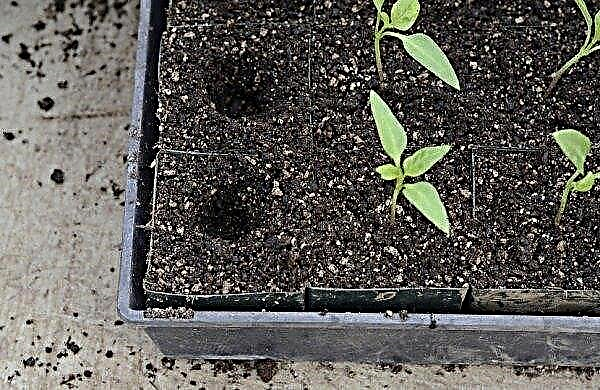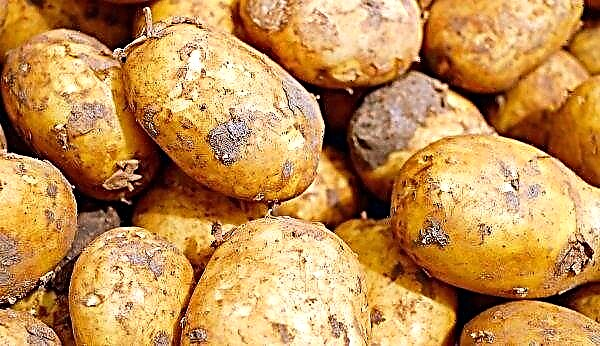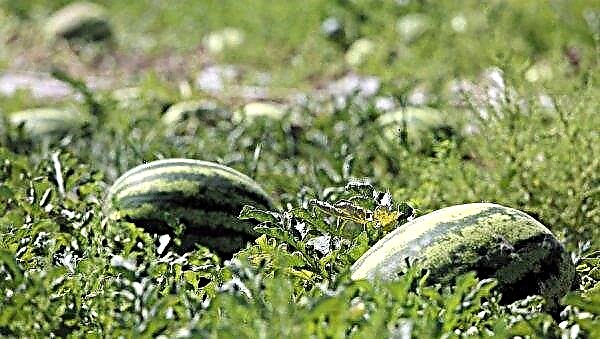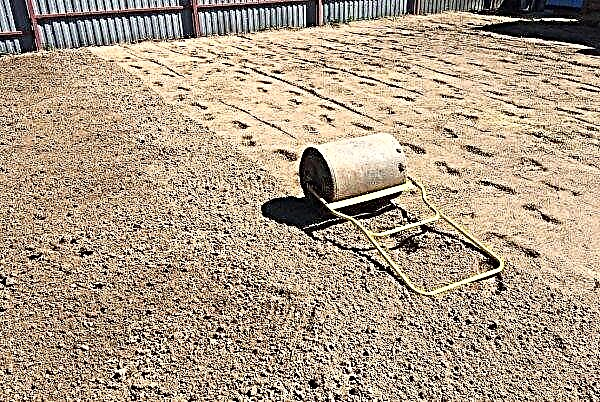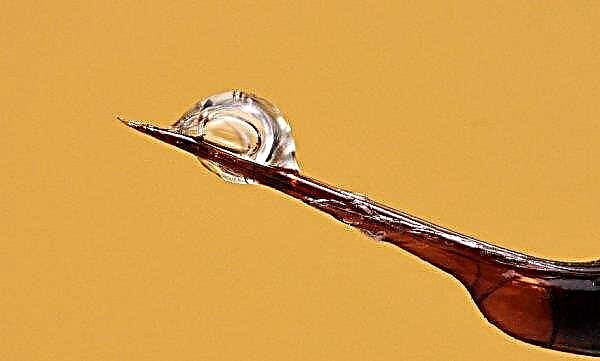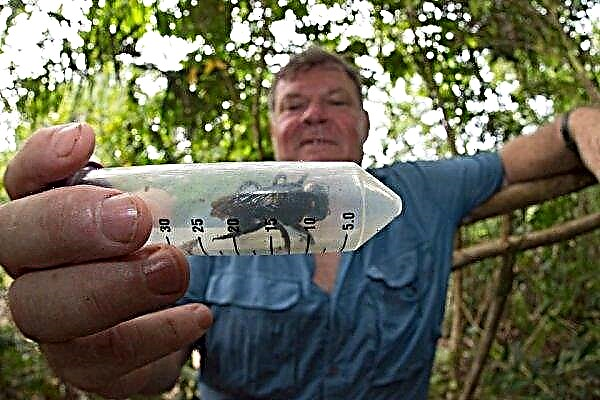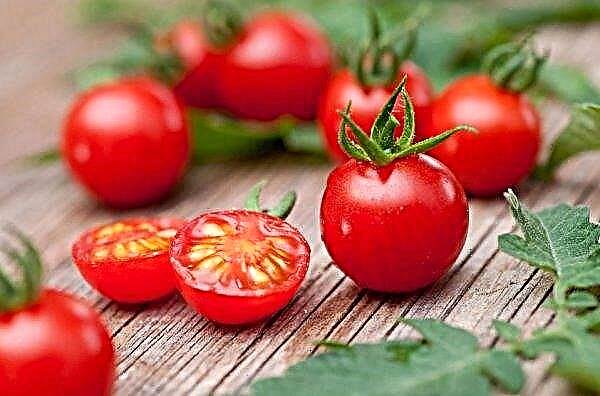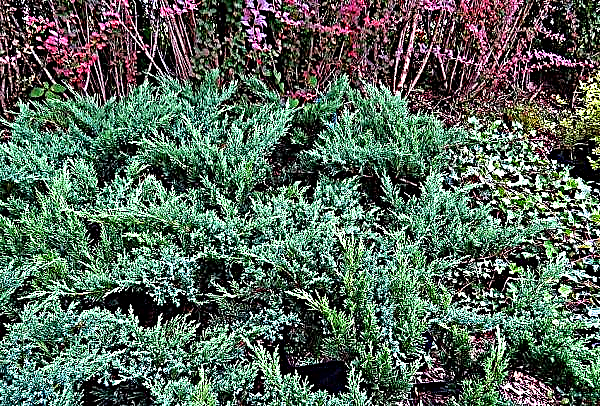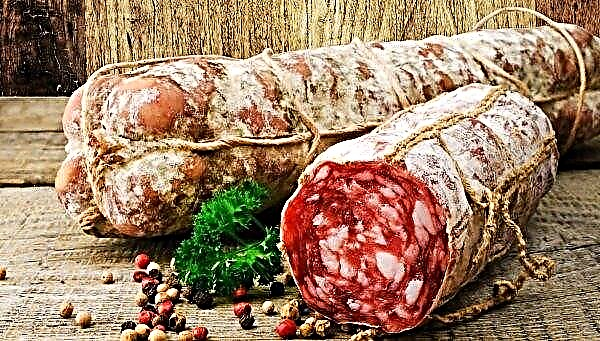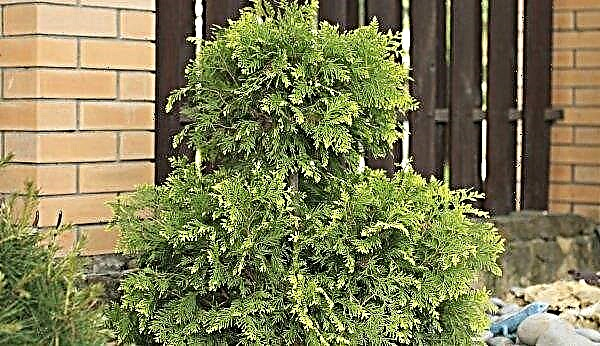Winter barley is grown as cereal and forage crops. It is used in the brewing industry because it contains little (10%) protein in its composition. What you need to know about this crop in order for cereal cultivation to bring a good harvest - later in the article.
Biological features of winter barley
Winter barley is an annual plant. The root system is fibrous, the stem is a hollow straw (up to 50 cm), divided in length by five internodes. Leaf blades are lanceolate, up to 30 cm long and about 3 cm wide, have parallel veins. Leaves cover the stem and grow from both underground and ground nodes.
Did you know? The name "pearl barley" comes from the word "perle" — pearl. Croup is produced from barley grains, from which the shell is removed and ground.
Leaf size and number depends on plant variety and growth conditions. Since this organ plays a crucial role in the process of photosynthesis, productivity directly depends on the number and condition of leaf blades. The plant blooms in June - July. An ear is four-sided or six-sided with an awn 10 cm long. For barley, self-pollination is characteristic, but cross-pollination is also possible. The fruit is a caryopsis. Seeds ripen in July-August.

Growth Requirements
Winter barley is the most sensitive to the temperature regime cereal of all winter crops. For this culture, prolonged periods with frosts below -15 ° C and snowless winters are fatal. With the onset of spring, the plant immediately enters growth, therefore, sharp fluctuations in temperature during this period are dangerous for it. Shoots appear after snow melts, with the first warm sunshine. The optimum temperature for growth is +6 ... + 8 ° С.
The plant prefers fertile soil with a pH of 6–7.5 units. It grows well on sod-gley, chestnut, podzolic soils. It is not recommended to plant in sandy, sandy loam, loamy and clay soils.
To grow 1 ton of grain of winter barley, you need to make, kg:
- nitrogen - 35 kg
- phosphorus - 12 kg
- potassium - 22 kg.
Potassium phosphate fertilizers close up during sowing. This contributes to hardening and improves resistance to frost. Fertilizing with nitrogen fertilizers in early spring increases productivity.
The need for barley in moisture is the lowest compared to all other crops. The formation of 1 kg of barley grain requires 0.31-0.52 tons of water. This culture well “assimilates” winter precipitation, although their abundance can adversely affect growth.
 An important factor affecting productivity is moisture supply in the period from earing to ripeness of grains.
An important factor affecting productivity is moisture supply in the period from earing to ripeness of grains.
Crop rotation
It should be noted that crop yields are more dependent on the crop predecessor than on the applied fertilizer system. Barley yields 21% more after peas, lentils, clover, alfalfa, soybeans of early varieties than after barley. Legumes contribute to the accumulation of biological nitrogen in the amount of 60-180 kg / ha, which reduces the cost of fertilizers.
In the North Caucasus, winter barley is more often sown after silage maize, sunflower, potatoes and vegetable crops.
The best varieties
Among the best modern varieties, it is worth highlighting:
- PIC Meridian - a representative of six-row winter barley with high productivity and uniform ripening of grain and straw. The height of the culture is 99 cm. The variety has high resistance to ramolariosis and the yellow mosaic virus. It develops normally even with late sowing. It has high winter hardiness. Seeding rates - 300-450 pcs./ m². Depending on the timing, the sowing depth is 3-4 cm.
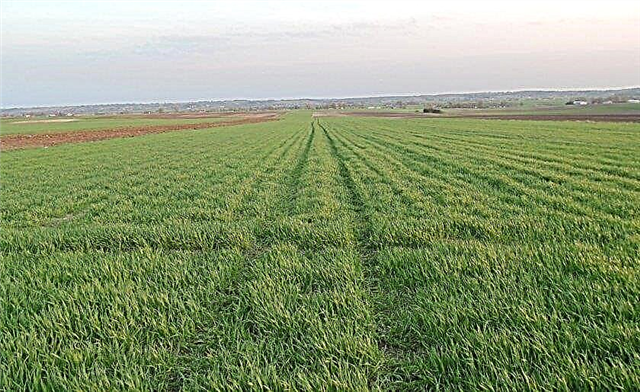
- Pic pic - a six-rowed variety of winter barley with a high yield potential and the ability to grow on poor soils. Plant height - 90 cm. It is highly resistant to powdery mildew, rhinchosporrosis and the yellow mosaic virus. Resistant to lodging and adapted to late sowing. Winter hardiness - medium-high.

- Wintmalt - two-row winter barley with high productivity. Height - 75 cm. The variety is resistant to rhinosporiasis, net blotch and the yellow mosaic virus. Productivity at a level with six-row barley. It grows well in late shoots in autumn and early spring. Winter hardiness is average. Used in brewing.

- Luran - a variety of six-rowed winter barley of Czech selection. The plant is 75 cm high. It belongs to the medium-late variety, has a high bushiness and spring regenerative abilities. Treatment with a fungicide to strengthen the stem is mandatory. The plant has a high resistance to disease and is characterized by high productivity and large grain. Resistance to lodging is above average, tolerates drought well. Productivity, on average, 95 kg / ha.
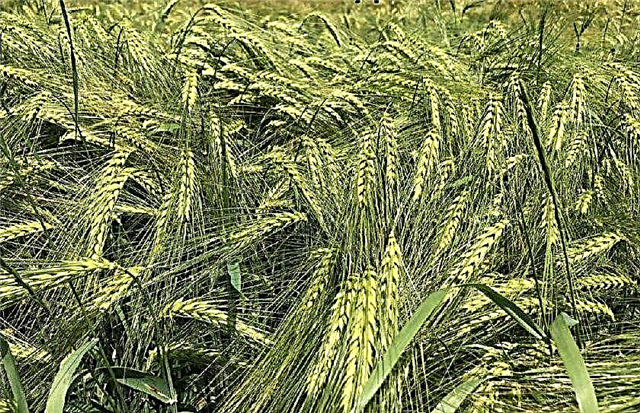
- Ninth Shaft - six-row winter barley, which according to the type of development belongs to the two-handed. Plant height - 120 cm, frost resistance and drought resistance are high. Productivity - up to 10.5 t / ha. Resistance to lodging is high. It has an increased immunity to powdery mildew and striped helminthosporosis. Leaf blades are not lowered, have a green color and a wax coating. The grain is large. Seed dressing and soil fertilization are mandatory during cultivation.
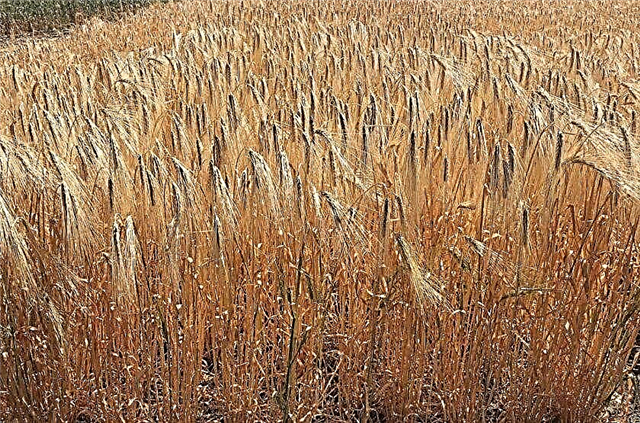
When to sow winter barley
If winter barley is sown ahead of schedule, it will outgrow and freeze in winter. The same situation can occur during warm autumn. If, due to high temperatures, the culture reaches the exit phase before the winter, then the winter hardiness of plants is significantly reduced.
Early crops are more often affected by diseases and pests. Being late with sowing also negatively affects crop yields. The plant is poorly developed, since the growth phases do not coincide with the necessary temperature indicators of the environment. The optimal sowing dates for winter barley depend on the climatic zone, and coincide with the end of the sowing period of winter wheat.
Did you know? In northern Italy, along with the classic risotto made from rice, a barley counterpart is common — orzotto.
Depending on the regions, the following dates for sowing winter barley should be distinguished:
- Far North (north of 60 ° north latitude) - August 15-30;
- Non-chernozem zone - September 1–20;
- The forest-steppe part of the Central Black Earth Region and the South-East - September 1–10;
- Southern steppe zone. Lower Volga - September 15 - October 1;
- Foothill areas of the North Caucasus - October 1–20.

Soil preparation for sowing
In the fall, soil treatment is carried out depending on its moisture and initial condition:
- in regions with sufficient moisture - stubble peeling with disc harrows to a depth of 12 cm;
- in arid areas - surface treatment to a depth of 6 cm;
- in very arid regions, slotting is recommended.
With a small amount of stubble, its peeling is carried out with light harrows to a depth of 8 cm. After peas for grain and silage corn, surface treatment for winter crops should be alternated with plowing - once, every 2-3 years. This will help in the fight against weeds, and increase productivity.
After husking the stubble, the soil is fertilized with mineral and organic fertilizers. The depth of plowing under winter crops is 20–27 cm. Along with the pass carry out harrowing. On heavy soils, if necessary, carry out disk harrowing and cultivation to a depth of seed placement.
After row crops with low soil clogging, plowing can be replaced by discing, followed by cultivation with harrowing. After processing the field should be sowing seeds.

Seed selection and preparation
Sowing requires quality material purchased from a certified manufacturer. When choosing a variety, you need to focus on the cultivation zone (steppe, forest-steppe, Polessye territories, etc.), climatic conditions in the region of cultivation and subsequent use of the harvested crop.
You should also pay attention to such varieties as Helios, Stalker, Decent, Vakula. For brewing seeds suitable Josephine, Canggu. Choosing the right seed is half the way to getting a good crop.
Seeds for sowing should be prepared. For this, material of the first or second class is selected. Further grains must be pickled, that is, to minimize the risk of manifestations of diseases and their pathogens that spread with the seeds. To do this, use: “Vitavax” at the rate of 3 l / t, “Kinto Duo” - 3.5 l / t or others. At the same time, you can use growth regulators and trace elements that stimulate development and increase productivity. The process is carried out using special machines 2-4 weeks before sowing.

Recently, varieties of transgenic barley two-handed have been widely used. They are more often used as insurance crops for winter barley.
- The above seeds have several advantages:
- Grains can be sown both in late autumn and in early spring - with the establishment of plus temperatures.
- Shoots tolerate temperature extremes.
- These varieties have a high yield compared to the "classic" varieties of winter barley.
- Seeds are suitable for both normal sowing and seedling.
- Plants have good winter hardiness, drought resistance and disease resistance.

Sowing methods
The depth of seed placement of winter barley depends on the type of soil and climatic conditions. Germination requires heat, moisture and oxygen to germinate. Moist soil is an important factor, since barley seeds are covered with a film and require a lot of moisture to germinate.
The deeper the planting material is placed, the greater the need for water increases, but at the same time, the access of oxygen decreases. Therefore, the time interval “from sowing to seedlings” may be delayed. This leads to a decrease in yield. Therefore, before sowing, it is necessary to take into account all factors, and determine the optimal depth of seed deposition.
On moist soils, the sowing depth is up to 3 cm, on heavy clay and loamy soils - 3-4 cm, on sandy - up to 8 cm.
Winter barley can be sown:
- In a continuous, ordinary way with 15 cm row spacing. This is the most common method in which seeds are placed evenly, which is its main advantage.
- Cross - with 15 cm aisles.
- Narrow-row - with 7-8 cm aisles.

Seeding rates per 1 ha
In order to get a good crop, you should choose the right seed rate, taking into account the characteristics of the soil and seed. Dense plantings lead to lodging of plants, a decrease in grain size and diseases. For winter barley, on average, the norm is 120–160 kg / ha.
On fruitful soils with good moisture, the sowing rate is 300 pcs / m². Such low rates provide for various activities that increase the bushiness of the plant: the selection of highly productive varieties, soil fertilizer, the use of growth regulators. The optimum sowing rate corresponds to 350 pcs / m². Under adverse conditions or delayed sowing, the amount is increased to 400 pcs./ m². In fields with low productivity, the norm corresponds to 450-500 pcs / m².
Proper care
Crop care involves providing plant nutrients, measures to protect crops from lodging, pests, diseases and weeds. A number of agricultural methods are used to increase productivity: post-sowing rolling, spring harrowing. They provide better wintering and improve grain quality.

Rolling and harrowing
After sowing soil rolling with a roller leads to its compaction and leveling of the surface. In dry weather, this process improves the contact of seeds with the soil, retains moisture in the soil and accelerates germination. Rolling can be carried out by a smooth and embossed roller. Plants formed by means of a relief skating rink form plants that differ from each other in development and growth. More snow accumulates in the pits on the soil, so the ice crust becomes looser and allows air to pass through. This improves wintering of winter crops.
Important! In the fields located on the slopes, harrowing is carried out across the slope. This will prevent sediments from eroding the soil surface.
Harrowing includes small tillage. It is used on crops of winter cereals in the spring in order to improve their condition and loosening the soil crust. This process accelerates the penetration of oxygen, nutrition and moisture to the roots. This increases the resistance of crops to adverse factors, and creates favorable conditions for the development of plants in the spring. This leads to an increase in productivity by 12–20%.
 The type of harrow should be selected based on the state of crops, the type of soil and the number of dry leaves.
The type of harrow should be selected based on the state of crops, the type of soil and the number of dry leaves.
Harrowing is carried out in the fields of winter crops with plants that have many dried leaves, carrion plants, as well as on medium-developed crops growing in heavy clay soils. If the culture is in the period of the beginning of tillering, and also grows on light sandy loamy soils, that harrowing is carried out very carefully.
Important! The harrowing of underdeveloped, frozen crops, especially those growing on light soils, is prohibited. This can lead to the death of plants.
Top dressing
The amount of fertilizer to be applied to the soil depends on:
- region
- soil characteristics;
- predecessors;
- the presence of nutrients in the soil.
To calculate the amount of fertilizers, it is necessary to take into account that with a small yield (up to 60 kg / ha) up to 200 kg of nitrogen, 60–70 kg of phosphorus, 80–100 kg of potassium are “washed out” of the soil. Therefore, these chemical elements need to be replenished.

When growing winter crops, phosphate and potassium fertilizers are applied during pre-sowing tillage. For this, complex feeding is used: diamophos, nitroamophos, etc., up to 300 kg / ha. Great importance should be given to nitrogen fertilizers. The productivity and resistance of plants depends on them. In the spring, ammonium nitrate, 70–100 kg / ha, is applied to frozen soil to eliminate nitrogen starvation of plants. The following top dressing is carried out after tillering is completed. To control the plant growth, the growth regulator “Chloromequate-chloride 750” should be used.
Did you know? Barley groats are very useful for the work of the stomach and intestines. It contains vitamins A, B and trace elements - calcium, phosphorus, iodine, copper, as well as silicic acid.
Weed, Disease and Pest Control
Weed control technology is carried out by herbicides in different periods of growth, depending on the need:
- In phase 1-3 sheets - Granstar Gold, 20–25 g / ha.
- In the phase of 2–4 leaves - Lintur, 150 g / ha.
- In the phase of 3-5 leaves "Legato plus 600 COP", 1l / ha.
- Between the tillering and going out phases - “Agritox” (1–1.5 l / ha), “Dialen Super” (700g / ha), “Amine salt 2.4 D” - 2 l / ha.
Fungicides control diseases. In addition to the processing of seed, they also spray the plants themselves. Use drugs "Fundazol", "Ultrafit", "Title", "Carbesim" according to the instructions.
Barley pests can be aphids, thrips, bedbugs. If the number of insects is threatening for crops, you should use an insecticide (Fas, Bi 58, Fosorkan Duo, Decis, etc.) according to the instructions.

Harvesting
Harvest of winter barley begins earlier than other winter crops. It is important not to miss the right moment, as the ripened spike wilts and becomes brittle. This leads to crop losses. Harvesting can be carried out by direct combining or by a separate method.
A number of indicators that characterize barley ready for harvest should be highlighted:
- The moisture content of the grain is not more than 18%.
- It should correspond in size and color to a particular variety and be slightly wrinkled.
- Grain cracking when bitten.
- The seed sits well in the ear, but it can be removed from it completely.
- The color of straw changes from yellow to dirty gray.
- The nodes of the stems are brown in color.
- Straw breaks easily at the top of the stem.
Video: Harvesting winter barley
Growing winter barley is a long, time-consuming process with many subtleties. Compliance with agricultural technology of culture directly affects the final result. New varieties, modern methods of protecting plants from diseases, weeds, pests and the latest technical means will cope with all the difficulties and even the vagaries of the weather, which will significantly increase productivity.






